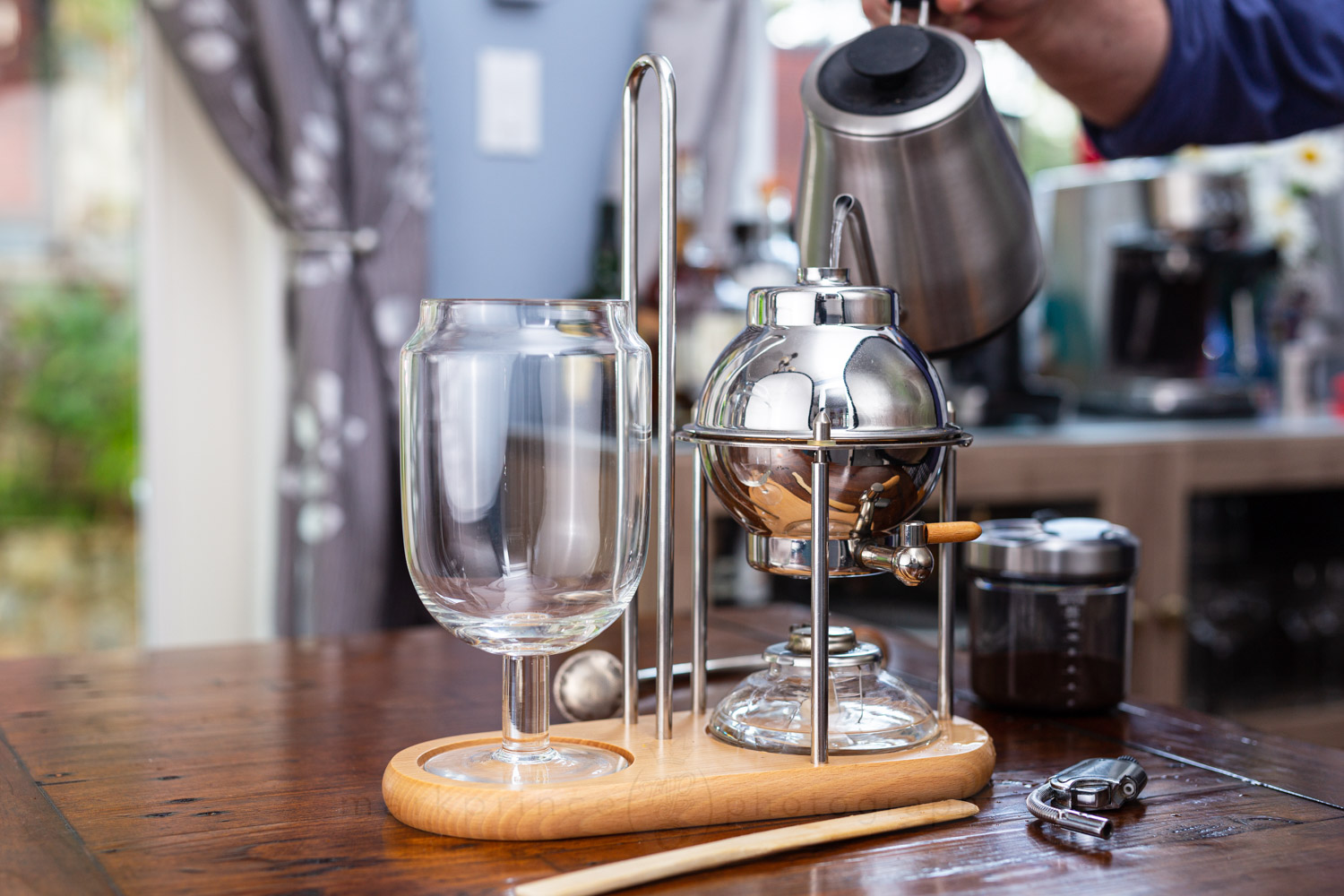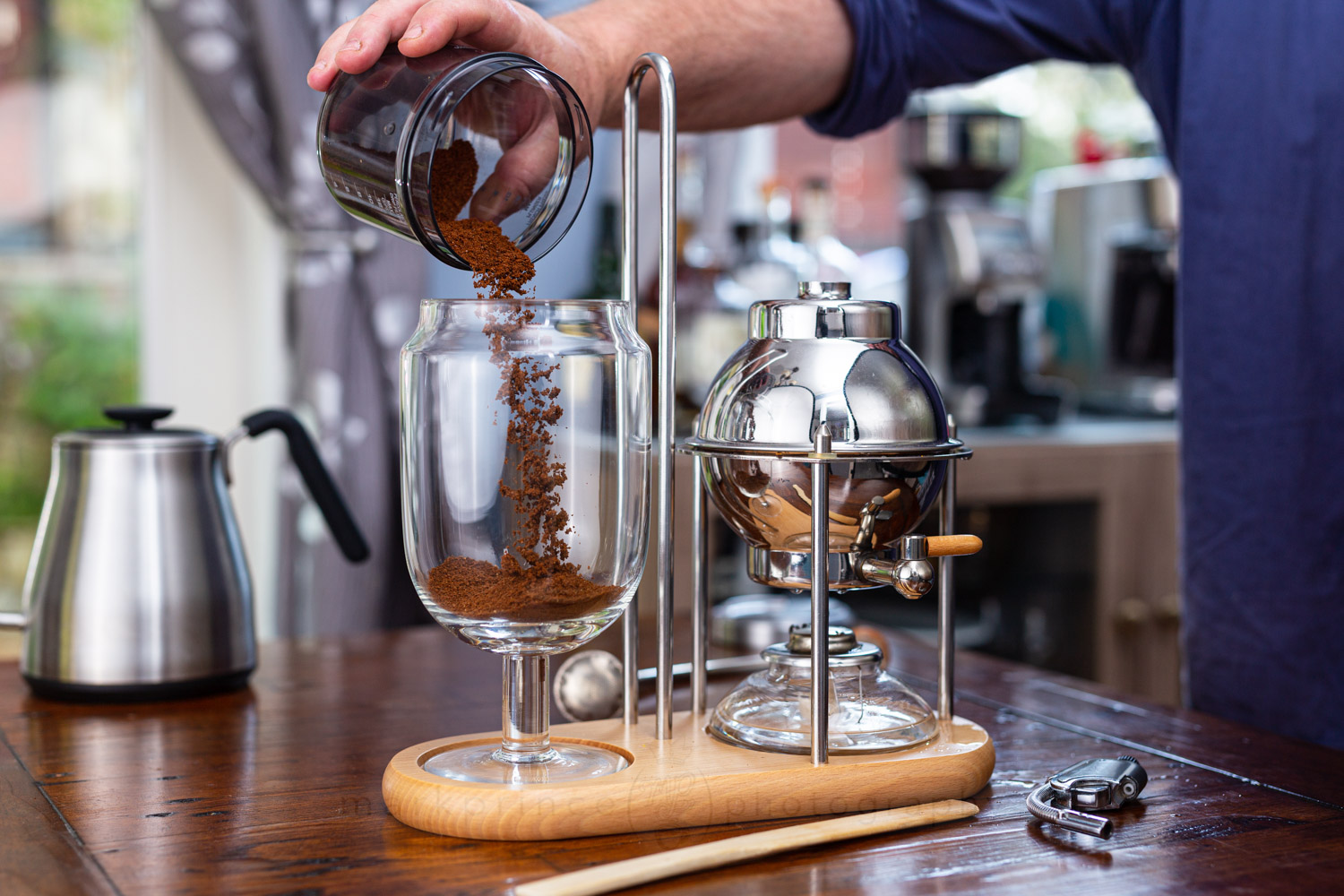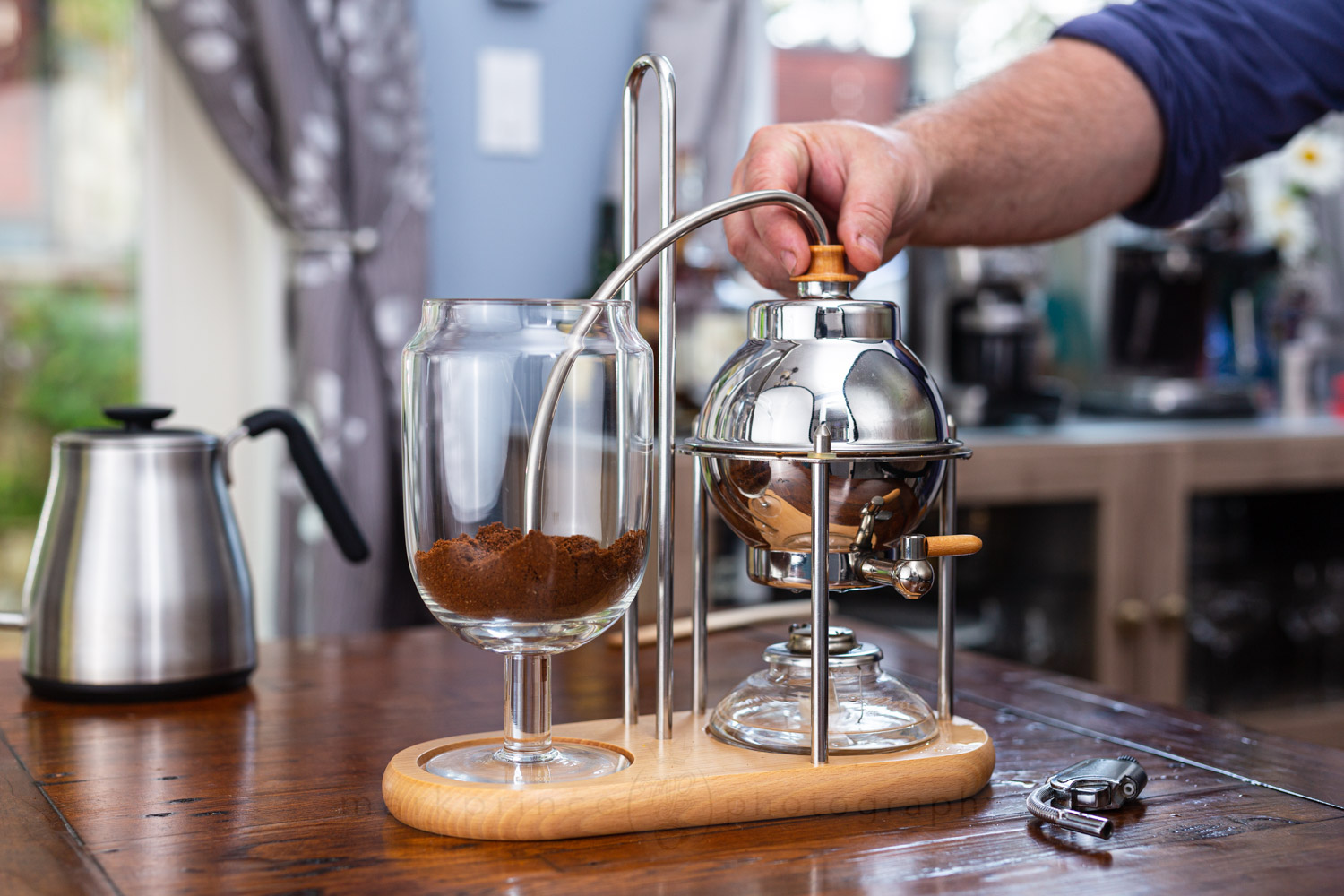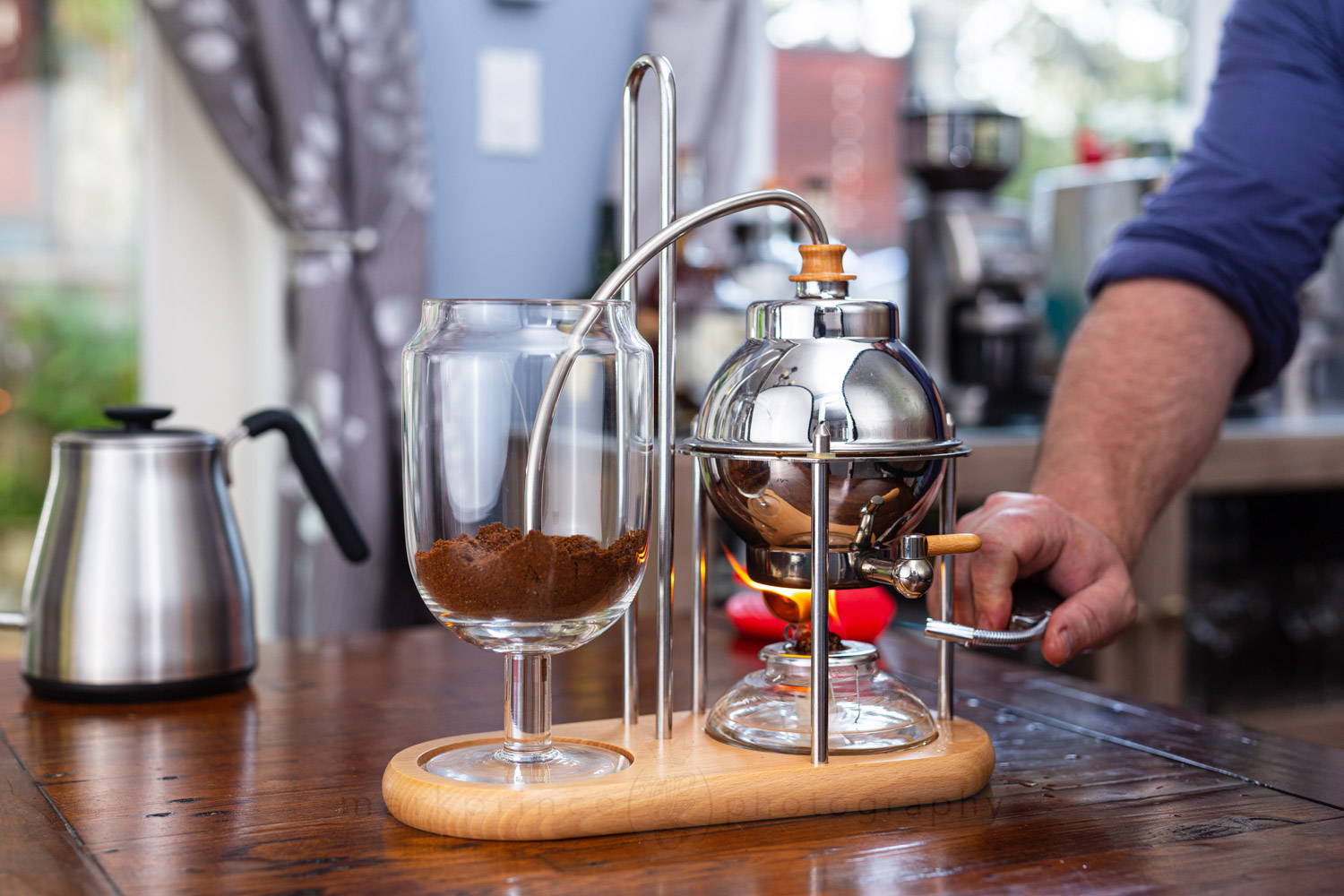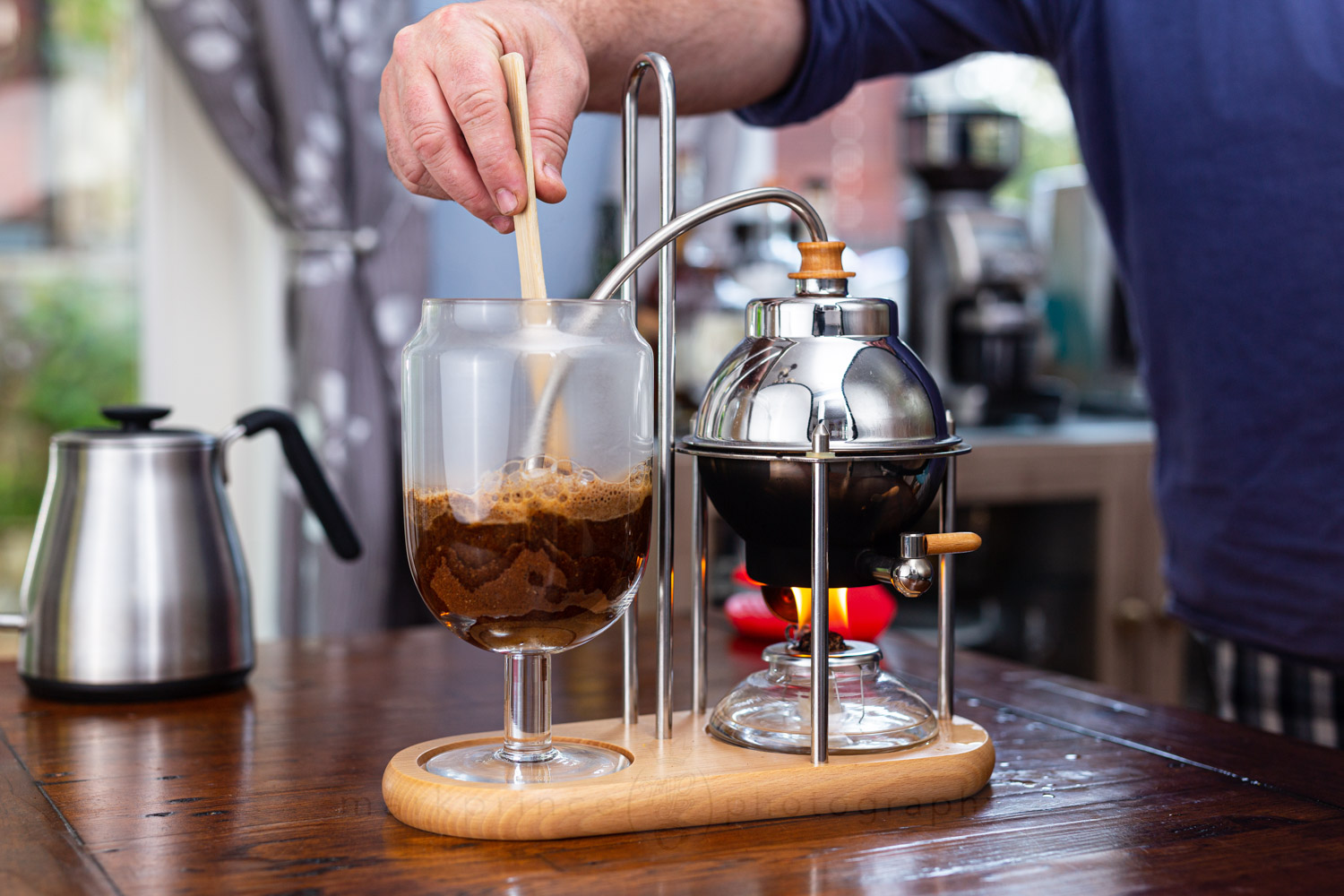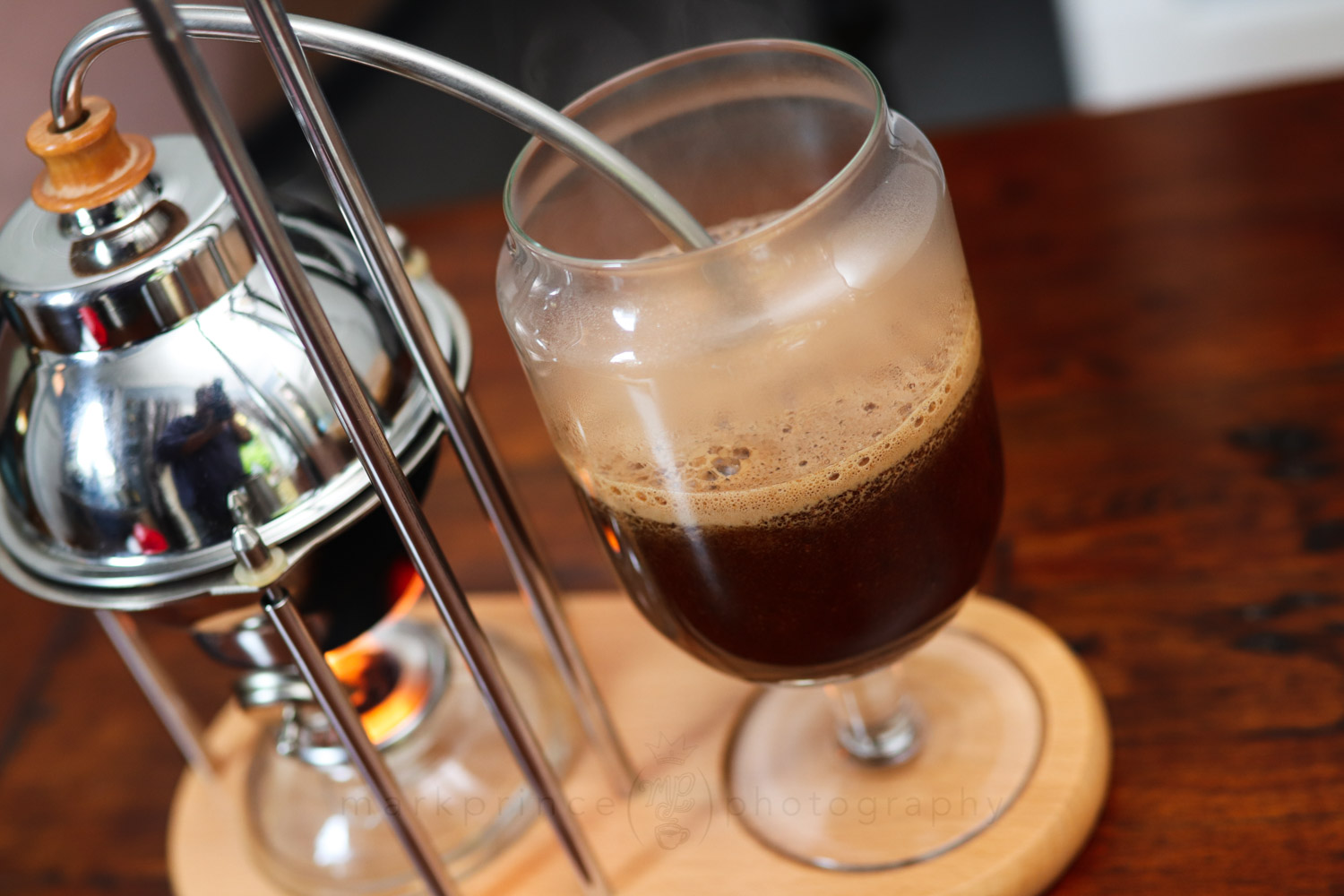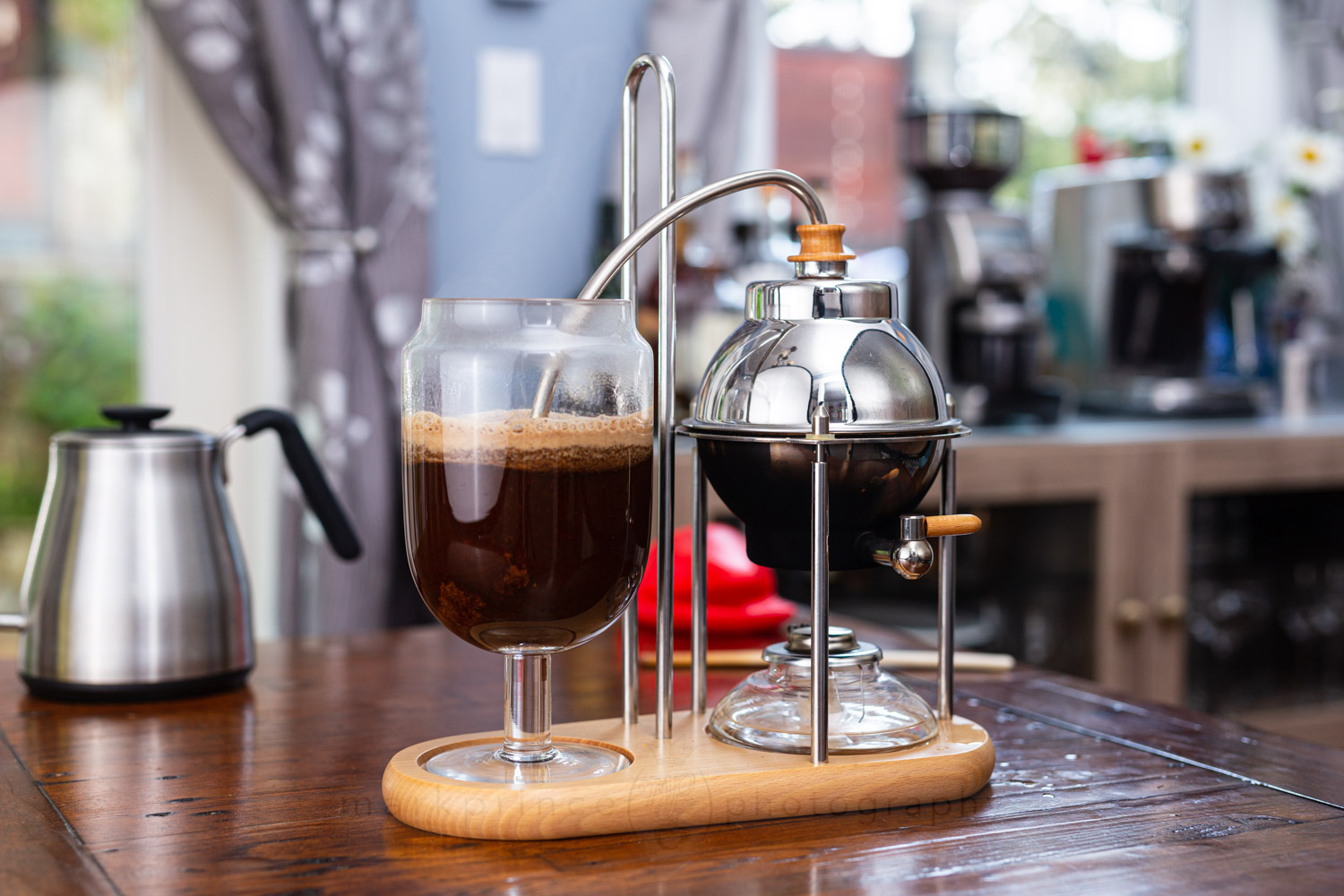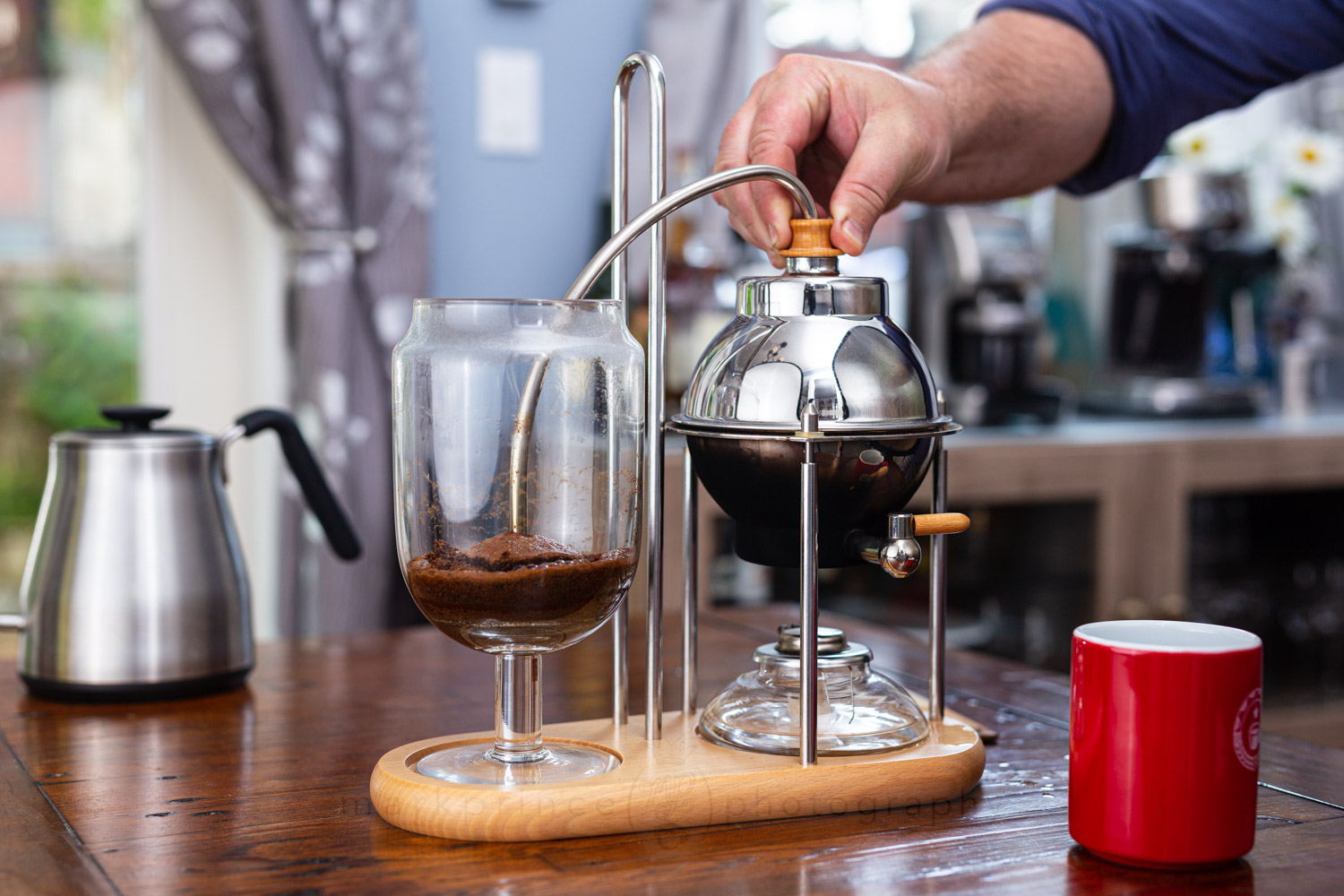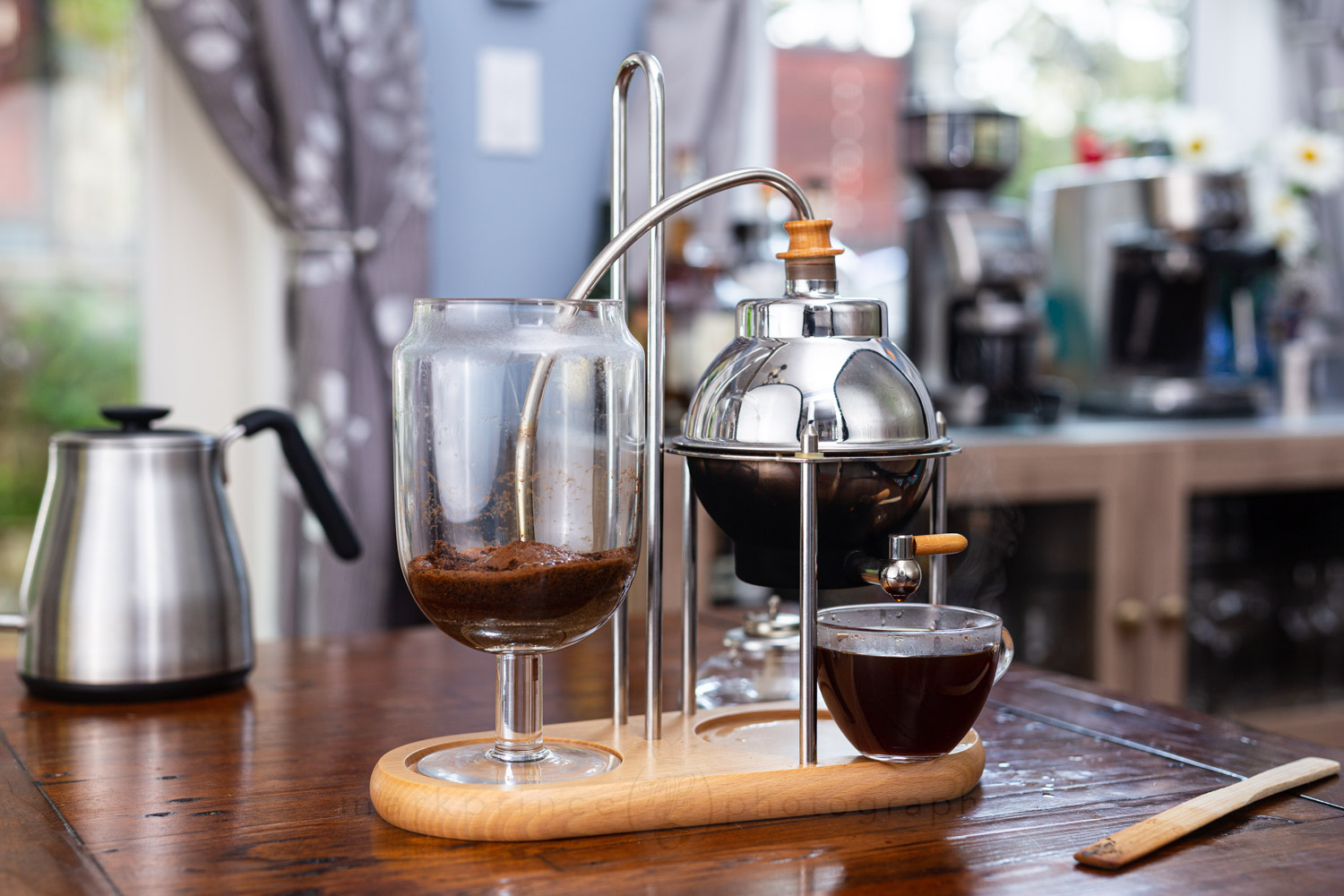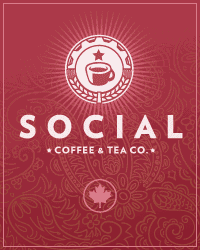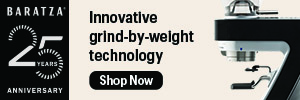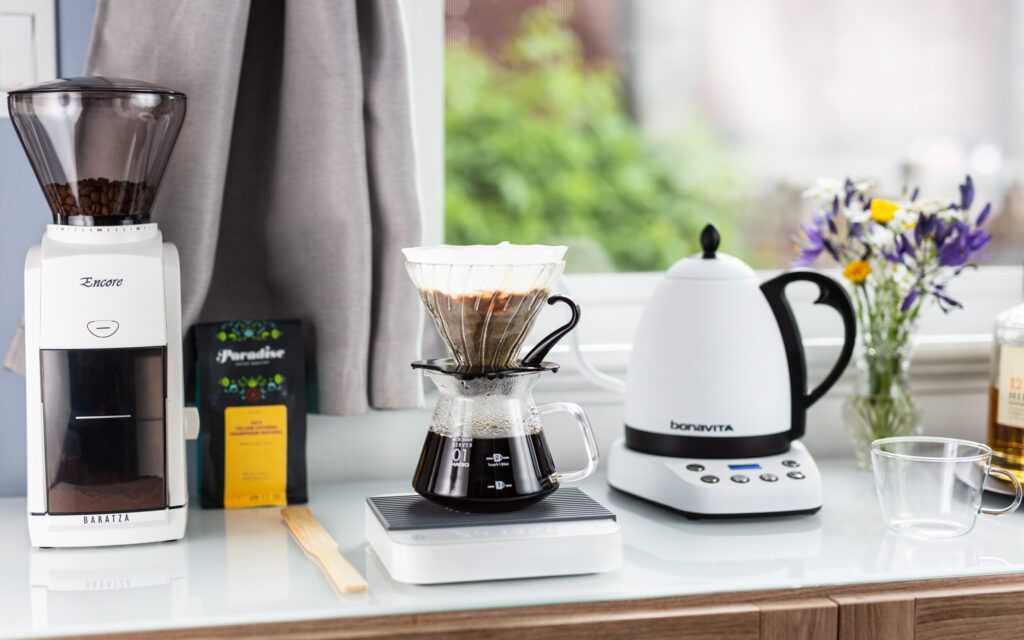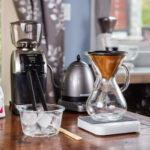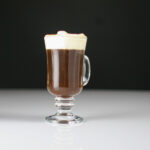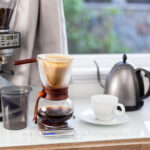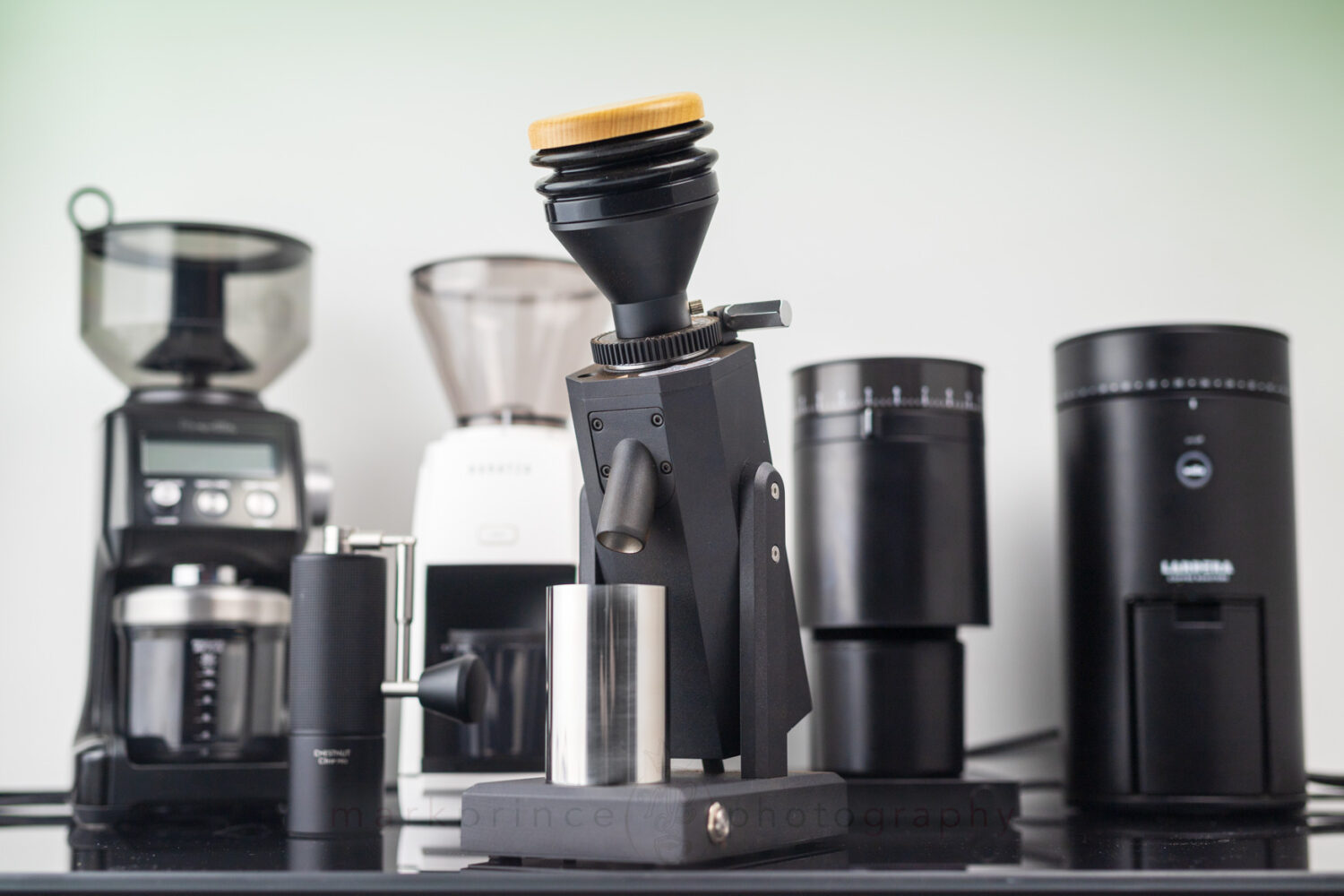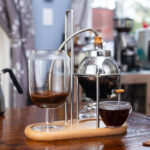Cafetino Balance Brewer
The Cafetino Balance Brewer, designed and manufactured by Patrick Van Den Noortgaete, a Belgian engineer, is one of the most strikingly beautiful coffee brewing devices I have ever seen or used. It brews coffee on the balance brewer principle, but without the use of counterweights. Instead, it uses calibrated springs to lower and raise the brewing kettle, which in turn causes a spring loaded cap to close down on the appliance’s cloth wick alcohol burner.
As far as I can tell, Van Den Noortgaete discontinued manufacturing this design in around 2010, and on the rare occasions these models do turn up on eBay, they go for well over $1,200 these days. I’m honestly surprised that the Chinese have not “knocked off” this model like they have the more traditional balance brewer.
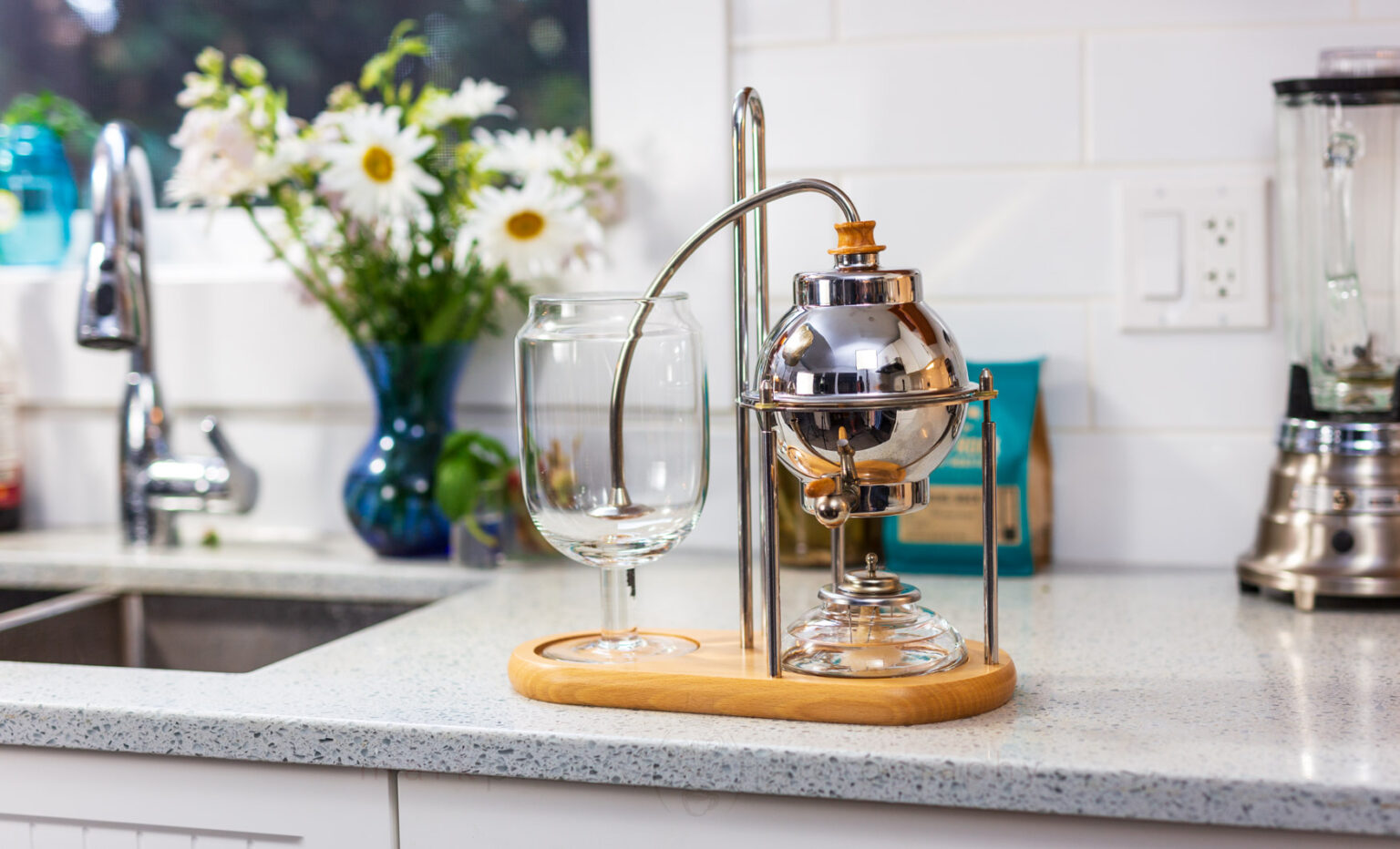
Time Needed: 5 minutes
Necessary Supplies
Necessary Tools
Cafetino Balance Brewer Steps
Set the Balance Brewer Up
In setting up your balance brewer, make sure all the parts are clean and ready to go. Your choice of fuel is important too. Denatured alcohol / methyl hydrate burns the cleanest, but the fumes can be a problem indoors if used in a very enclosed area (like a tent). In this how to, we’re using 99% Isopropyl alcohol which does produce soot, but not as much as 91% IPA does.
Remove Siphon Gasket
At this stage, remove the Cafetino’s siphon, which doubles as it’s seal (on traditional balance brewers, there is both a cap for pouring water, and a separate siphon connection hole; on this Cafetino, the siphon does double duty on top). Get ready to pour water in.
Add Water - Hot or Cold?
At this point, you’ll add a premeasured amount of water to the kettle, and you can choose to use heated (near boiling water), or room temperature or cold water. Keep in mind, if you add cold water, it will take the alcohol burner as much as 15 minutes or longer to heat it up to brewing temperatures. Because of this, we start with just-off-boil water.
Add Ground Coffee
Add your fresh ground coffee to the glass brewing side. Try to settle the grounds so they are even. The ratio is 8g of coffee per 100ml of brewing water used, because of the extra water remaining in the kettle during the brewing process. The grind, depending on your filter should be slightly finer than drip, but not by much.
Seal Things Up
After adding water, replace the Cafetino’s siphon with its built in gasket into the top of the kettle. I should point out the Cafetino’s gasket for the siphon tube is aged and a bit of a loose fit on top; when everything’s hot, it does seal up a bit more, but it’s not a perfect seal. As explained in the video below, I haven’t replaced it because I think the tiny amount of air it allows to leak into the kettle during the vacuum stage aids with overall brewing in this device (not by design!).
Carefully Lift Kettle, Insert Siphon Spigot
The kettle is almost literally boiling hot, so very carefully and with the aid of a cloth, glove or silicone guard, raise the kettle so you can open the alcohol burner’s flip down cap in order for the cap to be held open by the lowered kettle.
Light the Cloth Wick
At this point, light the alcohol burner’s cloth wick. As you can see, it produces a fairly wide flame that pumps out a decent amount of heat (compared to the smaller wicks you typically see on siphon brewers).
Wait for the Action
At this point, sit back and watch, and listen. You’ll soon hear the water in the kettle reaching boiling point, and the steam it produces will start forcing water up and over to the brewing glass side.
An Optional Quick Stir
When the glass brewing side looks like it has about half of the kettle’s hot water, you may want to give the grounds a quick and confident stir to fully saturate all the grounds.
Watch the Action
At this point, you can sit back again, and watch the brewing glass continue to fill up with brewing water. At some point very soon, the kettle will empty out enough (and be raised on its springs high enough) to allow the alcohol burner’s spring loaded cap to shut down. In the traditional brewer how to coming up next, I show you at this stage how you can prolong the brew, but for this Cafetino how to, we’ll let the kettle work in full automation mode.
Flame Extinguished
When the kettle lifts up enough, the cap on the alcohol burner will slam shut, extinguishing the flame. Because of this, no more steam will be produced in it, but instead the steam will contract and phase change back to water, creating a vacuum inside the chamber. That vacuum will draw back the brewed coffee from the glass brewer side via the siphon.
Drawback Time
Depending on the condition of your kettle, the siphon and its gaskets, the brewed coffee can be drawn back over into the kettle portion in as little as 20 seconds, or as long as 75 to 90 seconds. This Cafetino’s gasket is a bit loose, so the drawback is longer. I like it that way, as it extends an otherwise-too-short brewing time.
Drawback Completed
Once the drawback is completed (you can tell by the grounds in the brewing glass looking dry, with lots of popped air bubbles), you can serve the coffee. Keep in mind you need to create an air flow for the coffee from the kettle. There may be some air-flow from the siphon, but most of it is buried under spent coffee.
Loosen Siphon Gasket
Very, very carefully, loosen the balance brewer’s siphon gasket to create the airflow necessary to release coffee from the brewer’s spigot.
We also shot a video showing this process and brew. Check it out.
Step by StepReplica Balance Brewer
This walk through features a very traditional balance brewer. It was designed and manufactured in Belgium in 1999, and features a lot of brass and copper; the design is very faithful to an 1850s example of balance brewers.
This is also very similar to the typical models you can find on Amazon these days. I’m going to be doing some additional steps with this session, showing you ways to improve the brewed coffee. We’re also presenting this one as a slide show style display.
Pretty much any balance brewer you buy today will work just like the one detailed in this second how to. Most have metal kettle portions, but if you buy one that has a ceramic kettle side, just exercise a bit more care in the handling and flame application to it.
Deep DiveInto Balance Brewers
I’m a complete history nerd on coffee, and have done a fair amount of research into the origin of the balance brewer; the information is a bit more scattered compared to siphon brewers, but some is out there. Let’s dive in a bit on that.
Balance Brewer Origin and History
The siphon coffee maker was invented in the 1830s on paper, and realised in the early 1840s in France, with models being sold to well-to-do French-folk. During this time, there was another coffee device invented and manufactured in England, called the Naperian. Invented by the Scotsman James Naipier, it was a side-by-side brewer that moved liquids in one direction, only, via internal steam power generated in the brewer.
And in 1844, a fellow by the name of Adrian Emile Gabet filed a patent for something that married the two devices, calling it a Gabet. It was the first design for a balancing siphon, or a balance brewer. It self regulated and self extinguished its flame once the brewing was done. It was the world’s first true automatic coffee maker. It’s design was such to overcome some of the early siphon coffee makers’ biggest limitations.
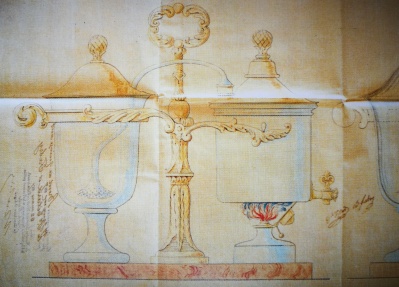
Gabet Patent
1840s siphons had a serious problem: they were fragile. The glass was not heat proof, and if the person using a siphon didn’t pay attention to the flame heating the water, it could easily run dry and crack the glass. Even if that didn’t happen, the possibility of the glass exploding from heat was very real, creating a serious hazard, as well as the loss of a very expensive home appliance.
Several innovative minds of the time found a solution to the siphon brewer’s issues, and their inventions became known as the balancing siphon, or balance brewer. Its design solved two problems while still using the siphon brewer’s method of making coffee. First, water was heated in a ceramic or metal “kettle” on one side, and a siphon travelled horizontally over to a glass brewer side where the ground coffee resided. This meant it was safer and less prone to explosions. Second, by making the kettle portion “balance” via a counterweight (or internal springs), a weighted cap could be automatically closed on the cloth wick oil stove used to heat the water once enough water had transported from the kettle to the brewing side.
One of the best things about the appliance was how “magical” it appeared to observers. Using science and the power of steam (which was foreign to the vast majority of people in 1850), the device would automatically brew coffee and move it from one side of the machine to the other, without human intervention. Entertaining… and magical.
The appliances proved their worth and improvements over the fragile siphon brewers, but their worth was pretty exceptional too. A balancing brewer could cost a household over $4,500 in today’s money, back in 1855. Because of this, not many were manufactured, and few from that era survive today in good shape. I’ve never seen one come up on eBay, for example, but I have seen a few come up for auction on famous auctioneer websites, and they typically go for $5,000, $10,000 or more depending on condition and materials used.
Balance Brewers Fade Away
There are many designs of balance brewers to be found in various collections around the world (including the Enrico Maltoni collection, the Bramah Collection and the Bersten collection) that were manufactured between 1850 and 1910; many were super ornate, featuring gilded porcelain or gold and silver designs. They were, in many ways, the ultimate presentation of coffee in an upper class home. Here’s just a few of them.
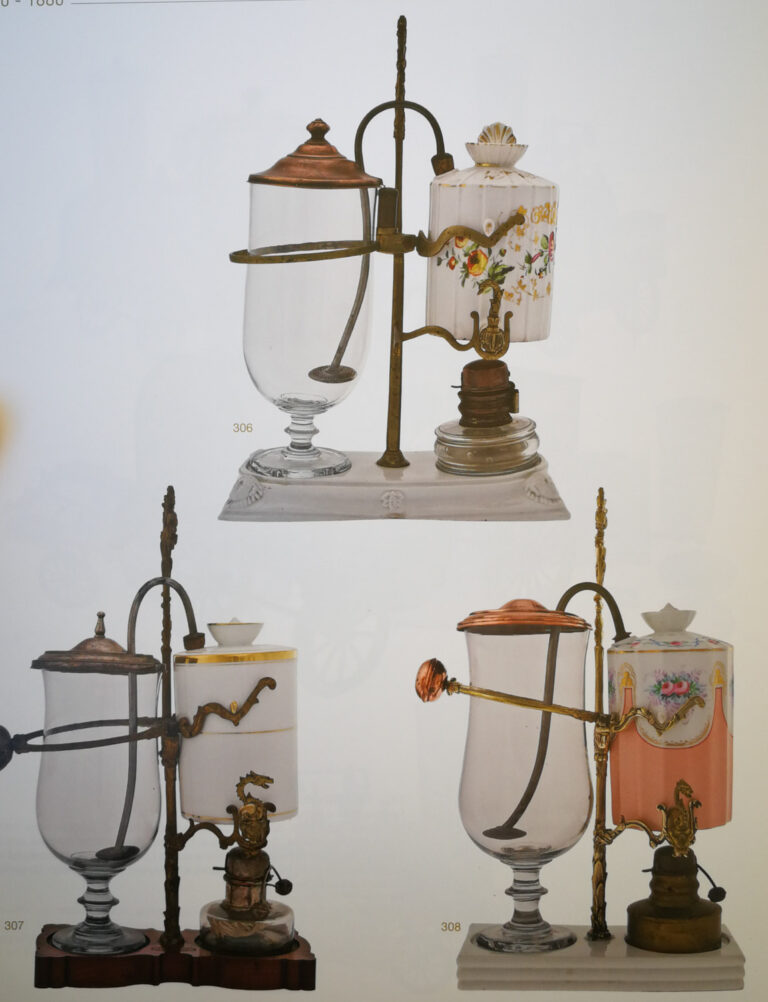
Three Examples
Two things killed off the balance brewer market: the introduction of safety glass (borosilicate from Schott, and Pyrex from Corning) for siphon coffee makers made them very safe, and Europe was moving more towards the espresso style beverage, with small, steam driven home machines popping up in Italy and France from 1918 onwards. The balancing siphon was still being made in Germany right up until 1930, including some electric models, but, according to Enrico Maltoni, one of the world’s foremost historical coffee machine experts, none were manufactured after 1930, and the last ones manufactured during that time were not of the best quality. The balance brewer market essentially died.
Here’s some of the last balance brewers made in that period, from Maltoni’s book, “CoffeeMakers: Macchine da caffe”.

Support CoffeeGeek
If you enjoy and learn from this resource, please consider making a one time or recurring donation to help support our work and fund purchases for future reviews.
Balance BrewerRevival
Fast forward to the 1990s, and a Belgian’s fascination with historical balance brewers. His name is Patrick Van Den Noortgaete, and he took it on himself to design and manufacture a balance brewer for sale in the modern age.
He produced two models (both the subjects of our visual how tos): the Royal Coffee Maker, a replica of an 1850s model, and the Cafetino, which is Van Den Noortgaete’s modern design of the brewing method. He quite literally revived a long dead brewing method, all on his own. So much so that many took to calling balance brewers “Belgian Coffee Makers”.
Van Den Noortgaete sold the siphons for several years, originally manufacturing them in Belgium, then moving manufacturing to Mexico. Because it was such a neat brewing method (it was also the subject of one of our earliest reviews on CoffeeGeek back in 2003), it got a lot of publicity in the early and mid 2000s. Mostly as a novelty, but in our forums, there were some absolutely dedicated balance brewer super fans who constantly debated their preferred methods for using the devices.
The popularity of Van Den Noortgaete’s brewers was such that several Chinese manufacturers decided to copy his designs; specifically the replica model. Which, to be fair, Van Den Noortgaete also copied. These Chinese makers began flooding the market with them around 2008, selling them for half to one third the Belgian’s prices.
It was too much for Van Den Noortgaete’s business, which shut down several years later.
Today, you can find a variety of balance brewers are listed up on Amazon, or buy them more direct (in bulk) from the manufacturers via websites like Aliexpress. They all work great, though the brewing sizes are smaller than Van Den Noortgaete’s revival appliances. What’s interesting is none of them have copied the Belgian’s modern take on the balance brewer (the Cafetino), instead all focusing on the replica models from the 1800s.
Today, Van Den Noortgaete’s brewers can fetch upwards of $1000 or more these days on auction sites; especially the Cafetino model, which rarely comes up. But you can easily procure a modern, Chinese model for under $130, and sometimes much less. Pair it up with a great grinder like the Breville Smart Grinder Pro and you’re good to go.
Balance brewers are such a fascinating brewing method, and one you’d do well to consider owning for you home, if for no other thing else than the show it offers. Not to mention some good tasting coffee.
















